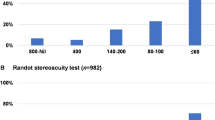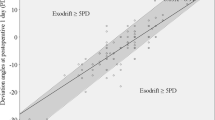Abstract
Exotropia is an outward deviation of the eye that may be constant or intermittent. Exotropia may be present in infancy (infantile or congenital exotropia) or may become manifest later in childhood or adulthood. Intermittent exotropia, the most common form, can be classified into (1) basic (distance = near deviation), (2) divergence excess (distance > near), (3) pseudodivergence excess (distance angle appears greater than near deviation) secondary to tenacious proximal fusion or a high accommodative convergence/accommodation (AC/A) ratio, and (4) convergence insufficiency (near > distance). This chapter will focus primarily on the diagnosis and management of intermittent exotropia. Subjective and objective assessment of the magnitude and patient’s control of the deviation guides management, which can be medical or surgical. Some controversy exists as to the most effective form of treatment and the optimal timing of interventions to promote and to maintain binocular visual development.
Access this chapter
Tax calculation will be finalised at checkout
Purchases are for personal use only
Similar content being viewed by others
References
Archer SM, Sondhi N, Helveston EM. Strabismus in infancy. Ophthalmology. 1989;96(1):5.
Chew E et al. Risk factors for esotropia and exotropia. Arch Ophthalmol. 1994;112(10):1349–55.
Matsuo T, Matsuo C. The prevalence of strabismus and amblyopia in Japanese elementary school children. Ophthalmic Epidemiol. 2005;12(1):31–6.
Mohney BG, Huffaker RK. Common forms of childhood exotropia. Ophthalmology. 2003;110(11):2093–6.
Govindan M et al. Incidence and types of childhood exotropia: a population-based study. Ophthalmology. 2005;112(1):104–8.
Nusz KJ, Mohney BG, Diehl NN. The course of intermittent exotropia in a population-based cohort. Ophthalmology. 2006;113(7):1154–8.
Chia A, Seenyen L, Long QB. A retrospective review of 287 consecutive children in singapore presenting with intermittent exotropia. J AAPOS. 2005;9(3):257–63.
Hunter DG, Ellis FJ. Prevalence of systemic and ocular disease in infantile exotropia: comparison with infantile esotropia. Ophthalmology. 1999;106(10):1951–6.
Kushner BJ. The distance angle to target in surgery for intermittent exotropia. Arch Ophthalmol. 1998;116:189–94.
Kushner BJ, Morton GV. Distance/Near differences in intermittent exotropia. Arch Ophthalmol. 1998;116(Apr):478–86.
Clarke MP. Intermittent exotropia. J Pediatr Ophthalmol Strabismus. 2007;44:153–7.
Hatt SR et al. Variability of angle of deviation measurements in children with intermittent exotropia. J AAPOS. 2012;16(2):120–4.
Stathacopoulos RA et al. Distance stereoacuity. Assessing control in intermittent exotropia. Ophthalmology. 1993;100(4):495–500.
Petrunak JL, Rao R. The evaluation of office control in intermittent exotropia: a systematic approach. Am Orthopt J. 2003;53:98–104.
Buck D et al. Grading the severity of intermittent distance exotropia: the revised Newcastle Control Score. Br J Ophthalmol. 2008;92(4):577.
Buck D et al. The use of the Newcastle Control Score in the management of intermittent exotropia. Br J Ophthalmol. 2007;91(2):215–8.
Haggerty H et al. The Newcastle Control Score: a new method of grading the severity of intermittent distance exotropia. Br J Ophthalmol. 2004;88(2):233–5.
Hatt SR et al. Improved assessment of control in intermittent exotropia using multiple measures. Am J Ophthalmol. 2011;152(5):872–6.
Mohney BG, Holmes JM. An office-based scale for assessing control in intermittent exotropia. Strabismus. 2006;14(3):147–50.
Holmes JM et al. New tests of distance stereoacuity and their role in evaluating intermittent exotropia. Ophthalmology. 2007;114(6):1215–20.
Hatt SR et al. Variability of stereoacuity in intermittent exotropia. Am J Ophthalmol. 2008;145(3):556–61.
Iacobucci I, Archer SM, Giles CL. Children with exotropia responsive to spectacle correction of hyperopia. Am J Ophthalmol. 1993;116:79–83.
Wu H et al. Binocular status after surgery for constant and intermittent exotropia. Am J Ophthalmol. 2006;142(5):822–6.
Freeman RS, Isenberg SJ. The use of part-time occlusion for early onset unilateral exotropia. J Pediatr Ophthalmol Strabismus. 1989;26(2):94–6.
Suh YW et al. Conversion of intermittent exotropia types subsequent to part-time occlusion therapy and its sustainability. Graefes Arch Clin Exp Ophthalmol. 2006;244(6):705–8.
Caltrider N, Jampolsky A. Overcorrecting minus lens therapy for treatment of intermittent exotropia. Ophthalmology. 1983;90(10):1160–5.
Rowe FJ et al. Intervention for intermittent distance exotropia with overcorrecting minus lenses. Eye (Lond). 2009;23(2):320–5.
Watts P, Tippings E, Al-Madfai H. Intermittent exotropia, overcorrecting minus lenses, and the Newcastle scoring system. J AAPOS. 2005;9(5):460–4.
Eibschitz-Tsimhoni M et al. Current concepts in the management of concomitant exodeviations. Compr Ophthalmol Update. 2007;8(4):213–23.
Hatt SR, Gnanaraj L. Interventions for intermittent exotropia. Cochrane Database Syst Rev. 2013;5, CD003737.
PEDIG. A randomized clinical trial of observation versus occlusion therapy for intermittent exotropia. 2010; http://clinicaltrials.gov/show/NCT01032330.
Piano M, O'Connor AR. Conservative management of intermittent distance exotropia: a review. Am Orthopt J. 2011;61:103–16.
PEDIG. A randomized trial comparing part-time patching with observation for children 3 to 10 years of age with intermittent exotropia. Ophthalmology. 2014;121(12):2299–310.
Kushner BJ. Diagnosis and treatment of exotropia with a high accommodation convergence-accommodation ratio. Arch Ophthalmol. 1999;117:221–4.
Abroms AD et al. Timely surgery in intermittent and constant exotropia for superior sensory outcome. Am J Ophthalmol. 2001;131(1):111–6.
Romanchuk KG, Dotchin SA, Zurevinsky J. The natural history of surgically untreated intermittent exotropia-looking into the distant future. J AAPOS. 2006;10(3):225–31.
Richard JM, Parks MM. Intermittent exotropia: surgical results in different age groups. Ophthalmology. 1983;90(10):1172–7.
Hiles DA, Davies GT, Costenbader FD. Long term observations on unoperated intermittent exotropia. Arch Ophthalmol. 1968;80(10):436–42.
Buck D et al. The improving outcomes in intermittent exotropia study: outcomes at 2 years after diagnosis in an observational cohort. BMC Ophthalmol. 2012;12(1):7.
Raab EL, Parks MM. Recession of the lateral recti. Arch Ophthalmol. 1969;82:203.
Pratt-Johnson JA, Barlow JM, Tilson G. Early surgery in intermittent exotropia. Am J Ophthalmol. 1977;84(5):689–94.
Hardesty HH, Boynton JR, Keenan JP. Treatment of intermittent exotropia. Arch Ophthalmol. 1978;96(2):268–74.
Kushner BJ. Selective surgery for intermittent exotropia based on distance/near differences. Arch Ophthalmol. 1998;116(Mar):324–8.
Maruo T et al. Intermittent exotropia surgery in children: long term outcome regarding changes in binocular alignment. A study of 666 cases. Binocul Vis Strabismus Q. 2001;16(4):265–70.
PEDIG. A randomized trial of bilateral lateral rectus recession versus unilateral lateral rectus recession with medial rectus resection for intermittent exotropia. PROTOCOL AMENDMENT (4-30-10). 2010; http://clinicaltrials.gov/show/NCT01032603.
Archer SM. The effect of medial versus lateral rectus muscle surgery on distance-near incomitance. J AAPOS. 2009;13(1):20–6.
Author information
Authors and Affiliations
Corresponding author
Editor information
Editors and Affiliations
Rights and permissions
Copyright information
© 2016 Springer Science+Business Media, LLC
About this chapter
Cite this chapter
Marcotty, A., Utz, V.M. (2016). Management of Exotropia in Childhood. In: Traboulsi, E., Utz, V. (eds) Practical Management of Pediatric Ocular Disorders and Strabismus. Springer, New York, NY. https://doi.org/10.1007/978-1-4939-2745-6_51
Download citation
DOI: https://doi.org/10.1007/978-1-4939-2745-6_51
Published:
Publisher Name: Springer, New York, NY
Print ISBN: 978-1-4939-2744-9
Online ISBN: 978-1-4939-2745-6
eBook Packages: MedicineMedicine (R0)




